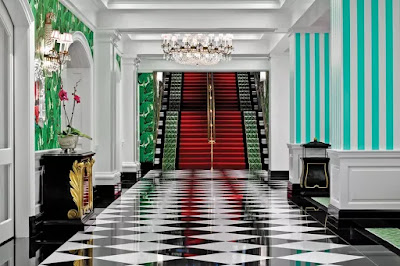WEEK 3 - Art Nouveau in the United States
In the United States, Art Nouveau was not a full-blown movement as it was in Belgium and France; however Louis Comfort Tiffany and Louis Henri Sullivan introduced America to this style of design. Sullivan was an gifted architect and drawer, and Tiffany was skilled in artistic painting, stain glass, furniture making and interior decorating. It is amazing that these two designers had a variety of skills, so they were able to influence different areas of design.
Louis Comfort Tiffany is considered the most Art Nouveau of any American artist. He came from a family of jewelers, merchants, and designers. From traveling in Europe and North Africa, he was exposed to Romanesque art and Islamic ceramics. These were the basis for his experiments with stained glass. He produced the stained glass windows of several American churches, and created many lamps. I find it interesting that some of Tiffany's work was eventually sold by Samuel Bing in Paris. This is evidence that his work was truly Art Nouveau.
[Louis Sullivan's contribution to Art Nouveau in America is discussed below under "One Step Further..."]
Current Applications:
Louis Comfort Tiffany is considered the most Art Nouveau of any American artist. He came from a family of jewelers, merchants, and designers. From traveling in Europe and North Africa, he was exposed to Romanesque art and Islamic ceramics. These were the basis for his experiments with stained glass. He produced the stained glass windows of several American churches, and created many lamps. I find it interesting that some of Tiffany's work was eventually sold by Samuel Bing in Paris. This is evidence that his work was truly Art Nouveau.
[Louis Sullivan's contribution to Art Nouveau in America is discussed below under "One Step Further..."]
Historical Examples:
 |
| The Holy City (1905) - St. John's vision on the isle of Patmos - One of the eleven Tiffany windows at Brown Memorial Presbyterian Church, Baltimore, Maryland. |
 |
| Dragonfly hanging shade - Glass Lamp by Louis Comfort Tiffany c.1905. Tiffany Studios. |
 |
| Ornamentation on the Wainwright Building. Designed by Dankmar Adler and Louis Sullivan (1891) Sullivan extensively blends the organic and geometric. |
Current Applications:
 |
| Leicester John Lewis Building, UK - Designed by Foreign Office Architects The ornamentation is organic, against geometric forms. |
 |
| Stained glass window at Val du Charron, Western Cape, South Africa It looks like it may have been inspired by Tiffany. |
One Step Further...
Louis Sullivan was trained in Paris; he studied at the École des Beaux Arts. However, his work was more of a reaction against Beaux Arts. He had two ambitions: one was to create an architecture appropriate to the new age; and the other was to create an American strain of architecture and derive an entirely new system of ornamental decoration. The ornaments he used in his designs were unclassical and based on American flora, not European.
Sullivan is known as "The Father of Skyscrapers." He thought of how buildings could be built vertically in confined spaces; and how the technology of steel could be used to support the weight of the building. He came back from Paris and worked in Chicago to contribute in rebuilding the city after the great fire. The video below, published by The Art Institute of Chicago summarizes all the great works Sullivan has added to the city of Chicago, and to American architecture.



Eunice,
ReplyDeleteIt was nice to see how in depth you went to study Tiffany and his beginnings. I find it interesting how he was influenced by so many cultures but still found the right design for each clientele.I also agree that Tiffany was more influenced Art Nouveau than that of Sullivan. Yet, as your video suggests, Sullivan had an important role too.
I agree with both of you saying that Tiffany's work was more Art Nouveau than Sullivan's. I think Sullivan's work has a mix of different styles that he tried to express in order to determine the American style and to really differentiate from the Europeans in general. Great post Eunice!
ReplyDeleteEunice,
ReplyDeleteVery nice summary of Louis Comfort Tiffany. I appreciate how you described his development as a designer. You also shared the various sources of inspiration that drove Tiffany to create such wonderful works. His most important technical development was the process of combining and layering hot glass with metallic oxides to create his glass collections.
Your summary and focus on Louis Sullivan was also informative. I appreciated the video you shared with us. The Carson Pirie Scott Building was his greatest contribution to the Art Nouveau movement.